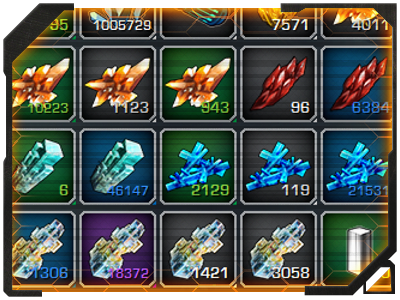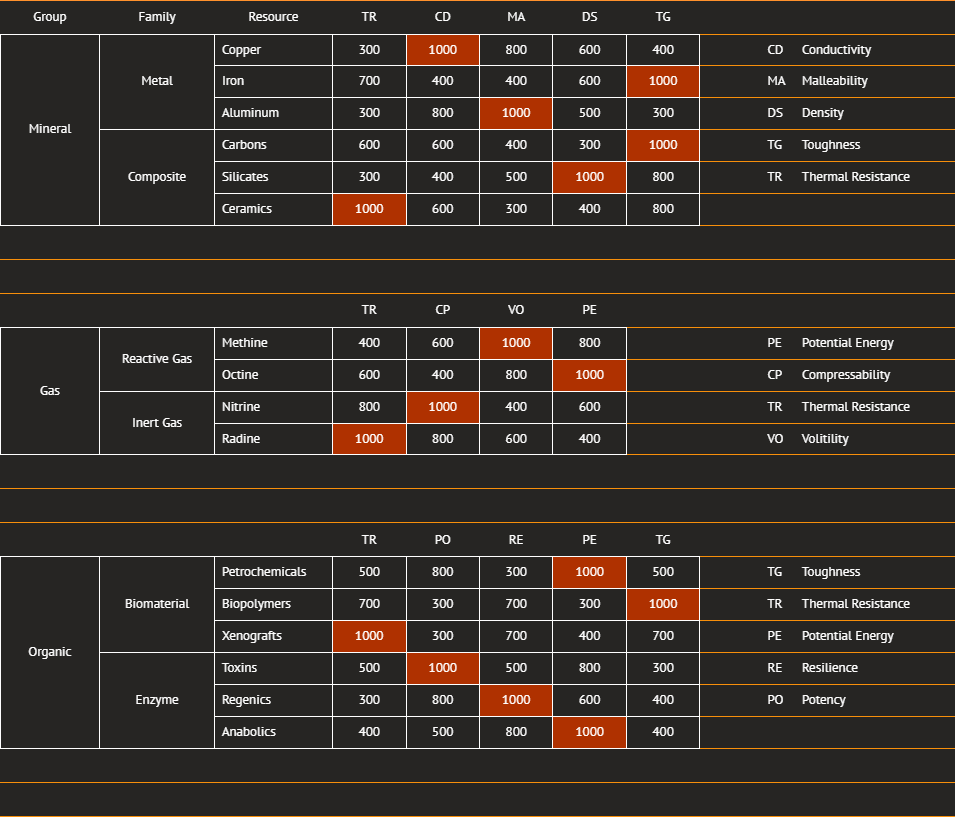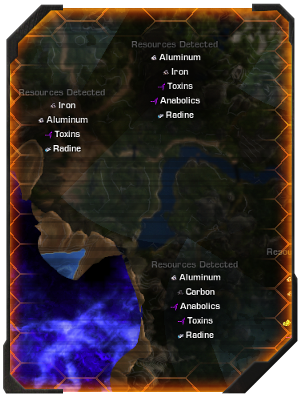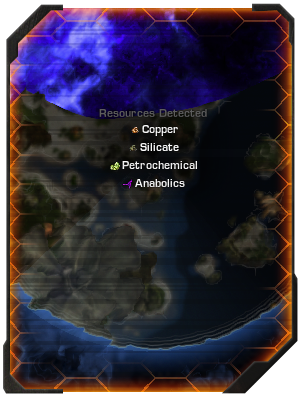
RAWR: Resources Guide
Materials used for crafting within Firefall are extremely varied. Not only by name and how they are gained but also in their individual properties, stats and purpose. The best place to start with understanding all this is to take materials as whole and break them down into easy to classify groups so you can get a feeling of what you can expect while in-game. This may seem like a lot to take in at first but once you have been playing for a short while it becomes much clearer.

RESOURCES AND LOOT
Every item in Firefall begins with a material. Something that, by itself, has no purpose but are essential for making items throughout the game. The products you can make will typically fall into two general categories; those which have a quality value and those which do not. For example, a Pack of Flares simply requires Crystite (the in-game currency) and 5RU of any Reactive Gas however a weapon like the Plasma Cannon will inherit the quality of the resources and components used to create it.There are many types of materials that may be found or awarded from a number of sources, you can classify them as one of the following types:
RAW RESOURCES
When a resource is first awarded from activities, found in supply crates, dropped from enemies or mined with Thumpers it initially cannot be used for crafting. Typically you will gather large quantities of raw materials which you need to then decide to refine or not.
REFINED RESOURCES
In the molecular printers there is a tab called 'Refine' in here you will initilly see only Raw Resource Refining I, you can research addition refining types which allow you to put more batches of resources in at once. All refining will take a certain amount of time and will continue while you are offline. For every 1 unit of resource (RU) the time to process is increased by 1 second. As you can imagine, this can mean that a large enough quantity of resources can potentially take more than a day to process.
DNA AND TECHNOLOGY
Enemies will sometimes drop items which are much like the junk items found in other MMOs. However, rather than selling these to an NPC vendor you will need to process these much like raw resources. You will find the option to do this under the Refine tab listed as 'DNA and Technology Processing'. In this option you will see that there are 4 types of processing which require different types of drops. As with raw resources the item created will be something that can be used for crafting.
COMPONENTS
Components are items that are used as parts in final products like weapons, armor and abilities. They typically inherit the quality of the materials used to create them based upon an average of the qualities from all parts. Therefore if you have a quality 1000 and a quality 500 component, the final product will be quality 750. Components are not commonly found as loot drops and are usually crafted by players or purchased from vendors.
SUB-COMPONENTS
Many of the DNA and Technology peices are processed into sub-components. These items do not typically have any affect upon the quality of the component they are inserted into. There is also previous gems which are awarded from events and earned randomly from thumping which are essential sub-components for Stage 3 and stage 4 crafting.

Resources are the most common form of crafting material you will need in Firefall. Just about any activity will reward you with raw resources like Copper, Radine and Xenographs however the main way to collect large quantities of a specific resource is to mine it from the ground using Thumpers. Resources will vary in quality, stats and rarity in a dynamic way called resource shifts however they can typically be found appearing in specific locations. These shifts occur depending upon a timer and player activity. The way it works is a seperate server at Red 5 Studios contains a database with all of the current resources that can be found throughout the game, these are consistant across shards however the resource veins themselves will be unique for each shard. This can lead to shortages of a specific overmined resource in one shard but a plentiful supply in another. All resources have a key value called Quality (QUAL). This value is the highest stat on the resource, because every resource has a single stat that they are uniquely potent in you can easily compare two types of the same resource and see which is better between the two. Typically the higher the quality the higher the stats will be in items you craft with it. The resource server creates a pool of each resource and distributes it across instances within veins, when that vein is exhauted it attempt to create another vein from the resource pool it has available. If the pool is emptied then a totally new resource will be created along with a new pool. This is why sometimes you may find Copper 500 and Copper 700 within the same instance, this is because one of these Copper resources is new and the other has now been exhausted from a previous pool.
In addition to players draining a resource pool there is also a periodic timer that will automatically remove all resources within a pool roughly every 7 days from the last time a new resource was created. Any deposits which have already will be cleared and replaced with something different. These resource shifts help to maintain a healthy player economy by ensuring that nobody will be able to monopolize the market with any specific item since the resources required are not unlimited in their supply.
In addition to the viens and pools there is a third factor which has to be considered. By design there are two resource lists which are used in different parts of the game. These are commonly referred to as the New Eden and Melding resource pools. New Eden's list of active resources are typically favouring a range of resources around Quality 500 with especially low and especially high quality resources appearing less frequently. The Melding pool however is designed to give a greater chance of high quality resources. This list is used for Tornado bubbles, viens near to the Melding wall and the resource viens within Melding pockets like Antarctica and Diamondhead.
FIREFALL RESOURCES IN DETAIL
When you first start stage 1 crafting the nanoprints will not require anything especially hard to find or need specific resources. Instead they will only require resources from certain resource groups. In Firefall these groups are Gas, Mineral and Organic. Within these 3 groups are Families of resources which are classified as Metal and Composite for the Mineral group, Reactive and Inert for the Gas group and Biomaterial or Enzyme for the Organic group. Have a look at the following chart to understand the classifications and groupings more easily:

*Numbers show the maximum quality of a resource per attribute
As you can see here each of the resource Groups also have specific properties. Minerals have Density, Conductivity and Thermal Resistance for example. Most of these properties are unique to each Group but some transend multiple groups such as Thermal Resistance. All resources will also specialize in one specific property which will often make them the 'best' for making items that require that property. In the Metals family Copper is the best Conductivity but Iron has the highest potential for Toughness. If an item you are making requires both Toughness and Conductivity then you will not be able to simply make a decision based upon the maximum possible value for each property, you will need to check to see what resources are available and which have the highest total for both of these properties. It is entirely possible for Iron to appear on the server with a value of 0 for Toughness and Copper to appear with a value of 200. This would therefore mean the 'best' resource for making that specific item at the time is actually Copper.
All resources have roughly the same total points distributed across their properties with a slight variation so they are largely equal in terms of best possible performance.
RESOURCE LOCATIONS
One of the most common questions players have is: Where do I find resources in Firefall? If you are ever struggling to find a resource it may be that you are looking somewhere it does not commonly appear. This is not to say it will never appear in certain places, but the chances are much lower. You can also check what resources are in certain areas by opening your map and pressing TAB. This will display resources detected around each Watchtower the Accord controls. Here are suggestions for where to more easily find resources based upon metrics gathered by the community:

COPPER
Typically along the northern edge of Accord territory with some smaller pockets found to the North-West and South-East of Copacobana.
IRON
Large sections of the mid-western region have been found to contain Iron and there is also large areas from the center of the map extending downwards. You can also find it around Sunkern Harbour.
ALUMINIMUM
Usually found to the North-West around Thump Dump and Cerrado Plains. Some results from the far South near to the Melding as well.
CARBON
Often found in the same regions as Iron. Namely in the mid-West, south from the center of the map and around Sunkern Harbour.

SILICATE
North of Copacobana and in the far North-East islands. Some common sightings of it north of Sunkern Harbour as well.
CERAMIC
Found across a wide area, almost everywhere to the West and South of the center of the world map. Almost none to the East and North.
METHINE
Often found with Aluminimum along the North-West and to the South.
OCTINE
Usally located around the same places as Ceramics. Namely in the West and South of the center of the world map.
NITRINE
Very common in the North-Eastern area and islands but rarely found anywhere else.
RADINE
Typically found along the Western side of New Eden across Cerrado Plains and down through to Stonewall.

PETROCHEM
Very common in the North-West and Northern regions around Thump Dump with scattered pockets in the mid South-West.
BIOPOLYMER
Commonly found along with Nitine along the North-East coast and islands.
XENOGRAFT
These appear commonly in the North-West along with Petrochems with scattered pockets to the South-West.
TOXINS
Widely found across the centre and mid-East of the world with additional deposits around the Sunkern Harbour region
REGENIC
Often found in the same place as Xenografts in the North-Western area.
ANABOLIC
Much like Biopolymer it is commonly found along the North-Eastern shores and in the islands.
RESOURCES AND BATTLEFRAME PROGRESSION
As a footnote here. Each resource group is used for unlocking certain parts of your battleframe constraints. Mineral is used for Mass which is used for defensive and movement gear, Gas is used for Power which governs the strength of abilities and weaponry and Organic is used for CPU that boosts your energy pool and allows for more powerful Abilities to be used. This can typically mean that since many players initially focus on Power and CPU constraints you will often find these resources are in higher demand. Furthermore there is also progression items that you need to craft in order to unlock the Stage 3 and Stage 4 constraint slots. You can read more about these in our Progression Crafting and NPC Vendor guide.
QUALITY COLOR CODING
For RPG-style game veterans, Firefall uses the classical rarity colour scheme you are most likely familar with already. If you are not familar however you will find that the table below is a useful guideline to tell the quality of a resource or item of gear at a glance.
